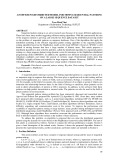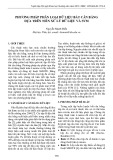1
Chapter 7: Data Visualization Charts
2
Outline
1. How to choose the right chart?
2. Bar Chart – Column Chart
3. Line Chart
4. Histogram
5. Scatter Plot
6. Violin
3
7. Other charts
1. How to choose the right chart?
• Data visualization is a technique to communicate insights from data through visual representation
• Main goal: is to distill large datasets into visual
graphics to allow for a straighforward understanding of complex relationship within the data
• It is important to choose the right chart for visualizing
4
your data
What story do you want to tell?
• It is important to understand why we need a kind of
• Graphs • Plots • Maps • Diagrams • ...
chart
• Relationship
• Data over time
• Ranking
• Distribution
5
• Comparison
Relationship
• To display a connection or correlation between two or
more variables
• When assessing a relationship between data sets, we are trying to understand how these data sets combine and interact with each other
• The relationship or correlation can be positive or
• Whether or not the variables might be supportive or working
against each other
6
negative
Relationship
• Scatter plot
• Histogram
• Pair Plot
7
• Heat map
Data over time
• Goal: to explore the relationship between variables to
find trends or changes over time
• The date/time appears as a link property between
variables, so a kind of relationship
• Line chart
• Area chart
• Stack Area Chart
8
• Area Chart Unstacked
Ranking
• Goal: to display the relative order of data values
• Vertical bar chart
• Horizontal bar chart or Column Chart
• Multi-set bar chart
• Stack bar chart
9
• Lollipop Chart
Distribution
• Goal: to see how a variable is distributed
• Histogram
• Density Curve with Histogram
• Density plot
• Box plot
• Strip plot
• Violin Plot
10
• Population Pyramid
Comparison
• Goal: to display the trends between multiple variable in datasets or multiple categories within a single variable
• Bubble chart
• Bullet chart
• Pie chart
• Net pie chart
• Donut chart
• TreeMap
• Diverging bar
• Choropleth map
11
• Bubble map
2. Bar/Column Chart
• A series of bars illustrating a variable’s development
• 4 types of bar charts: • Horizontal bar chart • Vertical bar chart • Group bar chart • Stacked bar chart
• This kind of chart is appropriated when we want to track the development of one or two variables over time
• One axis shows the specific categories being
compared (independent variable)
• The other axis represents a measured value
12
(dependent variable)
Vertical Bar Chart (Column Chart)
• not to display a continuous developments over an interval • discrete data • data is categorical and used to answer the question of how
• Distinguish it from histograms
many in each category
• Used to compare several items in a specific range of
values
• Ideal for comparing a single category of data between
13
individual sub-items
Vertical Bar Chart (Column Chart)
Quantitative Dependent variable
Benefits from both position (top of bar) and length (size of bar)
Discrete/Nominal Independent variable
14
Vertical Bar Chart (Column Chart)
import numpy as np import matplotlib.pyplot as plt
linear_data = np.array([1, 2, 3, 4, 5, 6, 7, 8]) exponential_data = linear_data ** 2
xvals = range(len(linear_data)) plt.bar(xvals, linear_data, width=0.3)
exp_xvals = [] for item in xvals:
exp_xvals.append(item+0.3)
plt.bar(exp_xvals, exponential_data, width=0.3, color='r')
plt.legend(['Linear data', 'Exponential data']) plt.show()
15
Vertical Bar Chart (Column Chart)
import numpy as np import matplotlib.pyplot as plt
linear_data = np.array([1, 2, 3, 4, 5, 6, 7, 8]) exponential_data = linear_data ** 2
xvals = np.arange(len(linear_data)) exp_xvals = [] for item in xvals:
exp_xvals.append(item+0.3)
fig, ax = plt.subplots() ax.bar(xvals, linear_data, width=0.3) ax.bar(exp_xvals, exponential_data, width=0.3, color='r') ax.legend(['Linear data', 'Exponential data']) ax.set_xticks(xvals + 0.3 / 2) ax.set_xticklabels(xvals) plt.show()
16
Horizontal Bar Chart
• Represent the data horizontally
• The data categories are shown on the y-axis
• The data values are shown on the x-axis
• The length of each bar is equal to the value
corresponding to the data category
17
• All bars go across from left to right • Use barh() function
Stacked Bar Chart
• Stacked bar charts segment their bars
• Used to show how a broader category is divided into
smaller categories
• The relationship of each part on the total amount is
also showed
• Place each value for the segment after the previous
one
• The total value of the bar chart is all the segment
values added together
• Ideal for comparing the total amount across each
18
group/segmented bar
Stacked Bar Chart
19
Stacked Bar Chart
20
3. Line Chart
• Line charts are used to display quantitative values over
a continuous interval or period
• Drawn by first plotting data points on a cartesian
coordinate grid and then connecting them
• Y-axis has a quantitative value
• X-axis is a timescale or a sequence of intervals
• Best for continuous data
• Most frequently used to show trends and analyze how
21
the data has changed over time
Line charts
Benefits from position but not length
Quantitative continuous dependent variable
Quantitative continuous independent variable
22
Line chart (pylab vs pyplot
from pylab import * t = arange(0.0, 2.0, 0.01) s = sin(2.5*pi*t) plot(t,s)
xlabel('time (s)') ylabel('voltage (mV)') title('Sine Wave') grid(True) show()
import numpy as np import matplotlib.pyplot as plt t = np.arange(0.0, 2.0, 0.01) s = np.sin(2.5*np.pi*t) plt.plot(t,s)
plt.xlabel('time (s)') plt.ylabel('voltage (mV)') plt.title('Sine Wave') plt.grid(True) plt.show()
23
Line chart (cont.)
import numpy as np import matplotlib.pyplot as plt linear_data = np.array([1,2,3,4,5,6,7,8]) exponential_data = linear_data**2 plt.plot(linear_data, '-o', exponential_data, '-o') plt.show()
24
Line chart (cont.)
import numpy as np import matplotlib.pyplot as plt linear_data = np.array([1,2,3,4,5,6,7,8]) exponential_data = linear_data**2 plt.plot(linear_data, '-o', exponential_data, '-o') plt.gca().fill_between(range(l en(linear_data)),
linear_data, exponential_data,
facecolor='blue',
alpha=0.25) plt.show()
25
Area Chart
• Built based on line chart
• The area between the x-axis and the line is filled in
with color or shading
• Ideal for clearly illustrating the magnitude of change
between two or more data points
• Use stackplot() function
26
• Or just fill in color the area between two lines
Area Chart
27
4. Histogram
• Histogram is an accurate representation of the
distribution of numerical data
• An estimation of the probability distribution of a
continuos variable
• Bin the range of values • Divide the entire range of values into a series of intervals • Count how many values fall into each interval
• To construct a histogram, follow these steps
• Bins are usually specified as consecutive, non-
28
overlapping intervals of variable
Histogram example
29
Histogram example
import numpy as np import matplotlib.pyplot as plt
fig, ((ax1, ax2), (ax3, ax4)) = plt.subplots(2,2,
sharex=True)
axs = [ax1, ax2, ax3, ax4]
for n in range(0, len(axs)):
sample_size = 10**(n+1) sample = np.random.normal(loc=0.0, scale=1.0,
size=sample_size)
axs[n].hist(sample) axs[n].set_title('n={}'.format(sample_size))
plt.show()
30
Histogram example
import numpy as np import matplotlib.pyplot as plt
fig, ((ax1, ax2), (ax3, ax4)) = plt.subplots(2,2,
sharex=True)
axs = [ax1, ax2, ax3, ax4]
for n in range(0, len(axs)):
sample_size = 10**(n+1) sample = np.random.normal(loc=0.0, scale=1.0,
size=sample_size)
axs[n].hist(sample, bins=100) axs[n].set_title('n={}'.format(sample_size))
plt.show()
31
Histogram example
32
5. Scatter plot
• A kind of chart that is often used in statistics and data
science
• It consists of multiple data points plotted across two
axes
• Each variable depicted in a scatter plot would have
various observations
• Used to identify the data’s relationship with each
variable (i.e., correlation, trend patterns)
• In machine learning, scatter plots are often used in regression, where x and y are continuous variable
• Also being used in clustering scatters or outlier
33
detection
Practice with Pandas and Seaborn to manipulating data
import pandas as pd import seaborn as sns import matplotlib.pyplot as plt
Import the dataset Iris
iris = pd.read_csv("../input/Iris.csv")
iris.head()
34
Practice with Pandas and Seaborn to manipulating data
35
Use scatter plot for Iris data
• Plot two variables: SepalLengthCm and SepalWidthCm
import pandas as pd import seaborn as sns import matplotlib.pyplot as plt
iris = pd.read_csv("../input/Iris.csv") iris.head()
iris["Species"].value_counts() iris.plot(kind="scatter", x="SepalLengthCm",
y="SepalWidthCm")
plt.show()
36
Use scatter plot for Iris data
• Display color for each kind of Iris
import pandas as pd import seaborn as sns import matplotlib.pyplot as plt
iris = pd.read_csv("../input/Iris.csv") iris.head()
iris["Species"].value_counts() col = iris['Species'].map({"Iris- "Iris- setosa":'r', virginica":'g', "Iris- versicolor":'b'}) iris.plot(kind="scatter", x="SepalLengthCm", y="SepalWidthCm", c=col)
plt.show()
37
Marginal Histogram
• Histograms added to the margin of each axis of a scatter plot for analyzing the distribution of each measure
• Assess the relationship between two variables and
38
examine their distributions
Marginal Histogram
import pandas as pd import seaborn as sns import matplotlib.pyplot as plt
iris = pd.read_csv("../input/Iris.csv") iris.head()
data=iris,
iris["Species"].value_counts() sns.jointplot(x="SepalLengthCm", y="SepalWidthCm", size=5)
plt.show()
39
6. Other kinds of chart Box Plot
40
• Box and Whisker Plot (or Box Plot) is a convenient way of visually displaying the data distribution through their quartiles
Box Plot
• What the key values are such as: the average, median, 25th
percentile etc.
• If there are any outliers and what their values are • Is the data symmetrical • How tightly is the data grouped • If the data is skewed and if so, in what direction
41
• Some observations from viewing Box Plot
Box Plot
import pandas as pd import seaborn as sns import matplotlib.pyplot as plt
iris = pd.read_csv("../input/Ir is.csv") iris.head()
sns.boxplot(x="Species",
y="PetalLengthCm",
data=iris)
plt.show()
42
Box Plot
import pandas as pd import seaborn as sns import matplotlib.pyplot as plt
iris = pd.read_csv("../input/Iris. csv") iris.head()
ax = sns.boxplot(x="Species",
y="PetalLengthCm", data=iris)
ax = sns.stripplot(x="Species", y="PetalLengthCm",
data=iris, jitter=True, edgecolor="gray")
plt.show()
43
Violin Plot
• Combination of the box plot with a kernel density plot
44
• Same information from box plot
Violin Plot
45
• Shows the entire distribution of the data
Violin Plot
46
• Histogram shows the symmetric shape of the distribution
Violin Plot • The kernel density plot used for creating the violin plot is
47
the same as the one added on top of the histogram
Violin Plot • Wider sections of the violin plot represent a higher probability of observations taking a given value
48
• The thinner sections correspond to a lower probability.
Violin Plot of Iris data
import pandas as pd import seaborn as sns import matplotlib.pyplot as plt
iris = pd.read_csv("../input/ Iris.csv") iris.head()
sns.violinplot(x="Spec ies", y="PetalLengthCm", data=iris, size=6)
plt.show()
49
Regression Plot
• Create a regression line between 2 parameters and
helps to visualize their linear relationships
• Example: data set tips of seaborn contains information
• the people who probably had food at the restaurant and
whether or not they left a tip
• the gender of the people, whether they smoke, day, time • Use seaborn’s function lmplot() to create regression
about:
50
plot
Regression Plot example
51
Regression Plot Example
• Show the linear
52
relationship betweet the total bill of customers and the tips they gave
Regression Plot Example
53
Distinguish two categories by sex
Heatmaps
• The underlying idea: replace numbers with colors
• The goal of heatmaps is to provide a colored visual
summary of information
• Heatmaps are useful for cross-examining multivariate data, through placing variables in rows and columns and coloring cells within the table
• All the rows are one category (labels displayed on the
left side)
• All the columns are another category (labels displayed
on the bottom)
• Data in a cell demonstrates the relationship between
54
two variables in the connecting row and column
Heatmap Example
55
Heatmap with seaborn
56
Heatmap with seaborn
57
Graphs
edge
node
58
Graphs
edge
node
If we add this edge then this would be a complete graph, also called a clique
59
Directed Graphs and Hierarchies
• Directed vs Undirected • Cyclic vs acyclic • Tree
• Minimally connected • N nodes, n-1 edges • Single parent node can
have multiple child nodes • Hierarchy
• Acyclic directed graph • Having a root node
60
Node Degree
• Degree of a node = number of edges
• Directed graph nodes have an in-degree and an out-degree • Social Networks
• Many low degree
nodes and fewer high degree nodes
• Also called power-law or scale-free graphs
61
Graph Visualization
• For visualizing more abstract and non-quantitative data
• The relationship/contacts of individuals in a population (also
called network of contacts)
• The hierarchical structure of classes in a module
• For example:
62
• Matplotlib does not support this kind of visualization
Roassal: an agile visualization tool
• Roassal is a DSL, written in Smalltalk and integrated in Pharo/Moose – an open source platform for software and data analysis
63
• Installing from: http://www.moosetechnology.org
Hierarchy
| b | b := RTMondrian new. b shape circle size: 30. b nodes: RTShape withAllSubclasses. b shape arrowedLine
withShorterDistanceAttachPoint
. b edgesFrom: #superclass. b layout forceWithCharge: -500. b build. ^ b view
64
Network structure
| b lb | b := RTMondrian new. b shape circle color: (Color red alpha: 0.4). b nodes: Collection withAllSubclasses. b edges connectFrom: #superclass. b shape
bezierLineFollowing: #superclass; color: (Color blue alpha: 0.1).
b edges
notUseInLayout; connectToAll: #dependentClasses.
b normalizer normalizeSize: #numberOfMethods min: 5 max: 50. b layout force. b build. lb := RTLegendBuilder new. lb view: b view. lb addText: 'Circle = classes, size = number of methods; gray links = inheritance;'. lb addText: 'blue links = dependencies; layout = force based layout on the inheritance links'. lb build. ^ b view @ RTZoomableView
65
Tree Map
• Maps quantities to area • Color used to differentiate areas • Shading delineates hierarchical
regions
• When to use?
• Limited space but large amount of
hierarchical data
• Values can be aggregated in the tree
structure • Advantages
• Saving space, display a large number
of item simultaneously
• Using color and size of areas to
detect special sample data
66
Tree map layout
1
1
1
1
1
2
1
1
1
1
2
1
2
67
Tree map layout
16
5
11
3
2
3
4
4
1
1
1
1
1
2
1
1
1
1
2
1
2
• Set parents node values to sum of child node
values from bottom up
68
Tree map layout
16
5
11
3
2
3
4
4
1
1
1
1
1
2
1
1
1
1
2
1
2
11/16
5/16
• Set parents node values to sum of child node
values from bottom up
• Partition based on current node’s value as a
portion of parent node’s value from top down
69
Tree map layout
16
5
11
4/11
3/5
3
2
3
4
4
1
1
1
1
1
2
1
1
1
1
2
1
2
4/11 11/16
5/16
• Set parents node values to sum of child node
values from bottom up
2/5
• Partition based on current node’s value as a
3/11
portion of parent node’s value from top down
70
Tree map layout
16
5
11
1/3
1/4
2/4 4/11
1/4
3
2
3
4
4
3/5 1/3
1
1
1
1
1
2
1
1
1
1
2
1
2
1/4
1/4
2/4
4/11 11/16
1/3 5/16
• Set parents node values to sum of child node
values from bottom up
1/3 2/5
• Partition based on current node’s value as a
2/3
3/11
1/3
1/3
portion of parent node’s value from top down
71
Thank you for your attention!!!
72


























